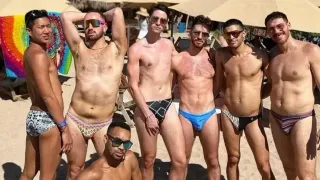
6 hours ago
Queer Slang 101: A Survival Guide for the Over-40s Crew
READ TIME: 3 MIN.
Language is a living, breathing aspect of any community, and nowhere is this more vibrant than in LGBTQ+ spaces. As digital platforms accelerate the spread of queer slang, terms like “serving,” “slay,” and “it’s giving” have leapt from drag stages and ballrooms into the mainstream, leaving many over-40s feeling linguistically outpaced. Yet, understanding these words is more than an exercise in being “hip”—it’s an essential act of solidarity, visibility, and respect within and beyond queer communities .
Much of today’s queer slang traces its origins to Black and Latinx drag ball culture in New York City during the 1980s, where LGBTQ+ people—often marginalized by race, gender, and sexuality—created their own spaces and vocabularies. Phrases like “serving” and “shade” were immortalized in the documentary "Paris Is Burning" and continue to shape global queer culture . Social media platforms like TikTok and Instagram have since mainstreamed these expressions, turning what was once in-group language into pop culture staples.
Key Terms
Serving - Used to describe someone embodying a particular vibe or look to perfection. “She’s serving executive realness” means she’s absolutely nailing a specific aesthetic .
Slay - To excel or impress, especially in performance or style. “You slayed that karaoke” acknowledges outstanding achievement—think of it as today’s “yas queen.”
Shade / Reading - “Shade” refers to a subtle, witty insult, while “reading” is the more direct, theatrical critique. Both are rooted in drag culture and have become tools for playful, affectionate banter .
Cishet - A blend of “cisgender” (identifying with the sex assigned at birth) and “heterosexual.” Used to describe people who are neither LGBTQ+ nor transgender .
Trade - Refers to someone considered attractive and masculine, often seen as potential romantic or sexual interest. The term has evolved from its original underground connotations to a more playful descriptor .
Enby - Short for “nonbinary,” describing someone whose gender identity doesn’t fit strictly within male or female categories. The term is a phonetic rendering of “NB” .
It’s giving… - A phrase used to describe a specific vibe, mood, or aesthetic. For example, “It’s giving suburban dad chic” means something evokes that particular style.
Mother - An honorific for someone who is considered iconic or legendary within the queer community. For instance, “Beyoncé is mother” positions her as a cultural matriarch.
Soft launch / Hard launch - “Soft launch” refers to subtly revealing a new relationship—perhaps a hand in a photo—while “hard launch” is a full, public declaration (like a couple’s selfie with a loving caption) .
Beyond mainstream queer slang, lesbian and sapphic communities have cultivated their own vocabulary:
Butch / Femme / Futch - Describe different presentations of gender expression, from masculine to feminine to somewhere in between .
Baby gay - Someone who recently came out and is new to the community .
U-Haul - The stereotype of lesbians moving in together quickly after starting a relationship.
LBD (Lesbian Bed Death) - Describes a perceived decline in sexual activity in long-term lesbian relationships—a term debated and often challenged .
Queer slang isn’t static; it morphs with each generation, adapting to new cultural moments and technologies. According to linguists, these terms foster group identity, signal in-group belonging, and provide tools for both resistance and joy . Digital platforms now accelerate this process, allowing slang to go viral overnight and cross linguistic boundaries. In French, for example, terms like “gouine” (dyke) have been reclaimed by some lesbians, while others remain pejorative .
For many over-40s, the rapid evolution of queer slang can be daunting. However, learning these terms is an act of allyship and inclusion. It recognizes the dynamic nature of LGBTQ+ culture and the importance of language in affirming identities, resisting erasure, and building community across age groups. As one linguist noted in Pride Month 2025, “Queer vocabulary is about visibility, resistance, solidarity, and joy. It tells stories—about culture, politics, humour, and belonging” .






